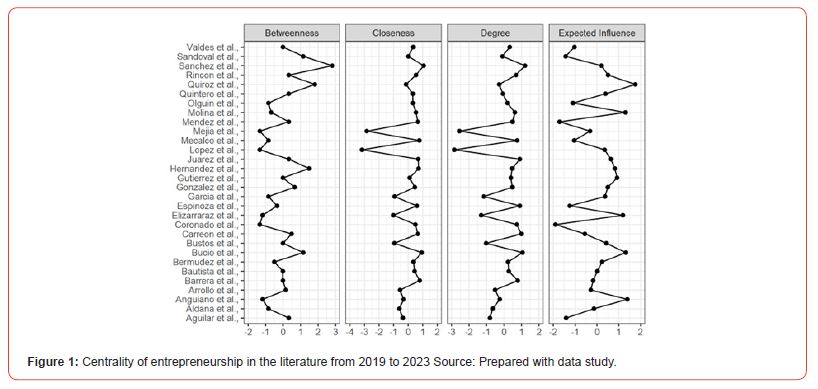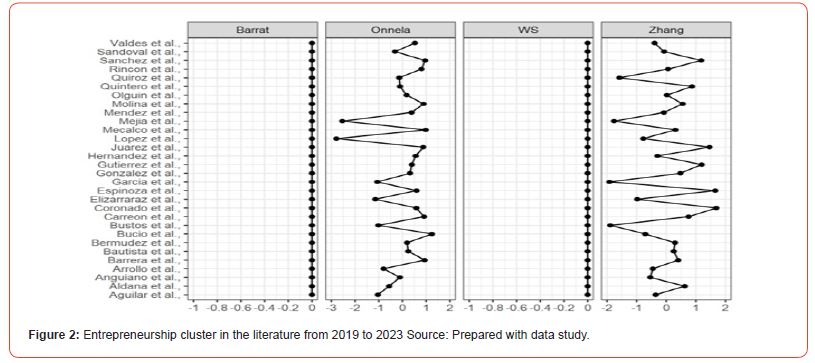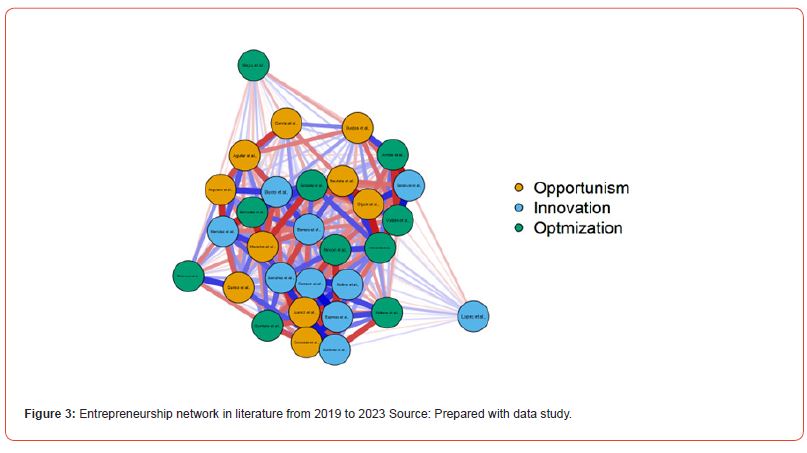 Research Article
Research Article
Entrepreneurship Networks in the Literature from 2019 to 2023
Cruz García Lirios1 and Gilberto Bermúdez Ruíz2*
1Autonomous University of Mexico State, Toluca
2South Anahuac University, Mexico
Gilberto Bermúdez Ruíz, South Anahuac University, Mexico.
Received Date: April 11, 2023; Published Date: May 08, 2023
Abstract
Entrepreneurship is an emerging phenomenon in crisis situations such as the pandemic. In the field of anti-COVID-19 policies, entrepreneurship is an indicator of local economic recovery. A documentary, exploratory, transversal and retrospective work was carried out with a sample of sources indexed to international repositories. A selection of findings related to entrepreneurship was made in the literature published from 2019 to 2023. Three dimensions alluding to opportunism, optimization and innovation prevail. Referring to the studies consulted, the scope and limits of the proposed network model are discussed.
Keywords:Agenda; COVID-19; Entrepreneurship; Innovations Diffusions; Local Development
Introduction
In the COVID-19 era, anti-pandemic policies impacted the economy and local development through distancing and confinement strategies [1]. The control and management of the coronavirus inhibited local productive dynamics. As the health crisis intensified, entrepreneurship emerged as a response from micro, small, and medium-sized companies to the risk scenario.
Research related to entrepreneurship suggests lines related to norms, values, beliefs, attitudes, intentions and behavior. In this way, the principles, conventions, information, decisions and actions unfavorable or favorable to confinement policies are structured in dimensions that reflect the exceptional situation [2].
Studies on the culture of entrepreneurship emphasize norms, values, and beliefs as factors indicative of differences between groups, organizations, or corporations in the face of the pandemic [3]. The impact of the epidemiological traffic light from which the degree of distancing and confinement is defined on the work culture is significant. To the extent that the traffic light indicates total confinement and distancing, the work culture is oriented towards entrepreneurship.
However, studies related to the culture of entrepreneurship focus their attention on the opportunities generated by microfinancing, economic crises or seed capital [4]. The limits of these studies are seen in stability. A positive balance of the local economy reduces the entrepreneurial culture. Consequently, the labor culture in crisis scenarios explains a process of generating and taking advantage of opportunities without considering visible innovations in stable contexts.
From the innovation diffusion approach, entrepreneurship is considered an added value [5]. Regardless of critical or stable situations, communities and organizations disseminate their contributions through protocols, use and customs that distinguish them from other locations. In this way, in the face of the pandemic, the diffusion of innovations is observed without any change because it is not due to a crisis. Precisely, by being a continuous and independent response to crisis scenarios, the diffusion of innovations finds its value as a systematization of common contributions.
Both perspectives, entrepreneurial culture and diffusion of innovations, unlink their purposes to the acceptance, utility and intensive use of technology [6]. From the optimal adjustment of technology to daily life, the pandemic is considered an area of opportunity that can be remedied by learning technology. In this way, given the risks of contagion, disease and death, the acceptance of devices that measure oxygen, pressure or temperature are technologies that, when adopted and considered useful, define their intensive management.
The technology acceptance theory suggests that opportunities and innovations are determining factors in the use of technology in a risk scenario [7]. The three approximations converge in entrepreneurship as an alternative to distancing and confinement.
The objective of this work was to explore the dimensional networks of entrepreneurship in the face of the pandemic, considering the approaches of work culture, diffusion of innovations and acceptance of technology in the literature published from 2019 to 2023.
Are there significant differences between the theoretical structure of entrepreneurship networks reported in the literature with respect to the observations made in this paper?
The premises that guide the study indicate that the approximations of labor culture, diffusion of innovations and acceptance of technology explain the findings published in the literature, but ignoring the relationship between the State and micro, small and medium-sized companies in the face of the crisis [8]. Such a sociopolitical relationship indicates that the government invested in microfinancing in order to reactivate the local economy and the processes of cultural, innovative and technological entrepreneurship. Therefore, significant differences are expected.
Method
This work is a documentary cut from studies from 2019 to 2023 search criteria keywords they are reviewed; “Entrepreneurship”, “innovation”, “utility”, “support”, “ease” or “accessibility” in international search engines: Dialnet, Latindex , Publñincex , Redalyc and Scielo considered bastions of information for a community.
The Systematic Review Inventory was used to record the relationship between the entrepreneurship categories and COVID-19. The expert judges rated the relationship between both categories considering the reported dimensions of the venture and the scenarios of exposure to contagion, illness, and death from the SARS CoV-2 coronavirus.
Scholar h-index. The objective and those responsible for the study were informed by institutional email [9]. The confidentiality and anonymity of their responses to the inventory of systematic review of the literature from 2019 to 2023 in international repositories on entrepreneurship were guaranteed in writing. The homogenization of the concepts was achieved through the technique of focus groups and the evaluation through the Delphi technique.
The information was captured in Excel and processed in JASP version 14. The coefficients of intermediation, proximity, gradualness and influence were estimated to be able to contrast the hypotheses about the significant differences between the structure of the research agenda with respect to the observations of the study with experts.
Values close to unity or greater were assumed as evidence of non-rejection of the hypothesis, but values less than zero were considered as evidence of rejection of the hypothesis [10]. The structure of relationship networks between the nodes was interpreted from left to right to infer the neural learning of the node configuration process.
Results

Figure 1 shows the centrality values that explain the proximity between the abstracts of the studies consulted. Sánchez is identified as the factor of greatest intermediation, López is the work of less proximity and gradation. Quiroz is the work with the greatest expectation of influence for 2023.
Figure 2 shows the grouping values that explain the configuration of the entrepreneurship structure published from 2019 to 2023. The works by López are the most dispersed with respect to the other studies. according to the Ornella parameter, but the research by Bustos is the most dispersed according to to the Zhang coefficient.
Figure 3 shows the values that explain the network structure of the company. López culminates the process of influence that began the work of Elizarraraz. In other words, the entrepreneurship network went from resource optimization to process innovation in the pandemic.


Discussion
The contribution of this work to the state of the art lies in the establishment of an explanatory neural network of the relationships between the findings related to entrepreneurship from 2019 to 2023. The results show the intermediation of studies that make up three dimensions: opportunism, optimization and innovation.
The opportunistic dimension is explainable from the work culture approach. If it is considered that 90% of micro, small and medium-sized companies are family-owned, then we must assume that opportunism is a central axis of the local entrepreneurial agenda [11]. Therefore, lines of study related to the culture of opportunism will anticipate the reactivation of the local economy.
The resource optimization dimension suggests a work culture and acceptance of technology [12]. Values, norms and beliefs underpin the systematic and value-added use of resources [13]. The principles, conventions and general ideas of saving resources explain an undertaking observable in traditional micro-enterprises [14]. Optimization as a process of acceptance of technology and willingness to change anticipates risk scenarios.
The dimension of innovation as diffusion and acceptance of technology explains the use of anti-COVID-19 devices for risk prevention [15]. From the perspective of dissemination, entrepreneurship is an innovation that concentrates local proposals in the face of the crisis [16]. Regarding innovation as a complement to the acceptance of technology, it explains the preventive measures that were adopted before COVID-19.
Conclusion
The objective of the study was to contrast the networks of findings reported in the literature with the neural algorithm that is a learning from the literature regarding entrepreneurship in the face of the pandemic. The results show the prevalence of three dimensions: opportunistic culture, optimization of resources and preventive innovation. The three dimensions anticipate risk exposure scenarios as areas of a venture that is distinguished by its prevalence.
Acknowledgement
None.
Conflict of interest
Author declared no conflict of interest.
References
- Nájera MJ, Aguayo JMB, Guillén JC, Lirios CG (2020) La percepción de riesgo en estudiantes universitarios ante la propagación del coronavirus SARS-COV-2 y la enfermedad COVID-19. Revista de Psicología de la Universidad Autónoma del Estado de México 9(17): 94-107.
- Guillén JC (2015) Compromiso laboral del trabajo social en el sector salud. Contaduría y administración 60(1): 31-51.
- Hernández-Valdés J, Carreón-Guillén J, Bustos-Aguayo JM, García-Lirios C (2018) Modelo de cibercultura organizacional en la innovación del conocimiento. Visión gerencial (2): 235-253.
- Guillén JC, Valdés JH, Aguayo JMB, Lirios CG (2017) Políticas de fomento empresarial y sus efectos sobre las percepciones de riesgo en caficultores de Xilitla, Sanluis Potosí, centro de México. Poiesis (32): 33-51.
- Guillén JC, Lirios MCG (2014) Teorías de la seguridad pública y percepción del delito. Margen 71: 1-16.
- Lirios CG, Guillén JC, Valdés JH, Flores MDLM (2014) Contraste de un modelo del compromiso laboral en centros de salud pública. Acta Universitaria 24(1): 48-59.
- Sánchez AS, Guillén JC, Ruíz HDM, Lirios CG (2018) Contratación de un modelo de formación laboral. Interconectando saberes, (5): 37-73.
- García Lirios C, Carreón Guillén J, Hernández Valdés J, Bustos Aguayo JM, Aguilar Fuentes JA, et al. (2016) Especificación de un modelo de hipermetropía sociopolítica. Luna Azul, (42): 270-292.
- Guillén JC, Flores MDLM, Varela BLR, Lirios CG, Valdés JH, et al. (2014) Emprendedurismo migrante y comerciante: Estado del conocimiento. Tlatemoani: revista académica de investigación, (15): 158-187.
- Guillén JC, Ugalde AB, Lirios CG (2018) Redes de violencia en torno a la gobernanza de la seguridad pública. Revista de Humanidades y Ciencias Sociales y Multidisciplinaria 60-65.
- Lirios CG, Guillén JC, Valdés JH, Miranda MB, Martínez AM, et al. (2012) Modelamiento de variables sociopsico-organizacionales a partir de la revisión del estado del arte. Revista de la Facultad de Trabajo Social 28(28): 13-60.
- Lirios CG, Guillén JC, Sánchez AS, Velázquez FRS, Flores MDLM, et al. (2016) Confiabilidad y validez de un instrumento que mide el liderazgo y la gestión educativa. EHQUIDAD. Revista Internacional de Políticas de Bienestar y Trabajo Social (5): 109-130.
- Burgos AV, Guillén JC, Paris AD, Sepúlveda JGE, Lirios CG, et al. (2018) Democracia, Gobernanza y Conductas éticas: ejes transversales en la formación. Opción: Revista de Ciencias Humanas y Sociales (86): 152-175.
- Fuentes JAA, Guillén JC, Lirios CG, Valdés JH, Ferrusca FJR, et al. (2016) Gobernanza de actitudes sociopolíticas. Perspectivas Rurales Nueva Época (27): 107-148.
- Guillén JC, Aguayo JB, Sánchez AS, Muñoz EM, Lirios CG, et al. (2020) La estructura del estrés laboral. Revista de Investigación Académica Sin Frontera: División de Ciencias Económicas y Sociales, (32): 1-23.
- Lirios CG, Guillén JC, Aguayo JMB, Valdés JH (2020) Percepción del emprendimiento caficultor en la región Huasteca, centro de México. Revista Activos, 18(1): 235-266.
-
Cruz García Lirios and Gilberto Bermúdez Ruíz*. Entrepreneurship Networks in the Literature from 2019 to 2023. Open Access J Addict & Psychol 7(2): 2023. OAJAP.MS.ID.000656.
Agenda; COVID-19; Entrepreneurship; Innovations Diffusions; Local Development
-

This work is licensed under a Creative Commons Attribution-NonCommercial 4.0 International License.






